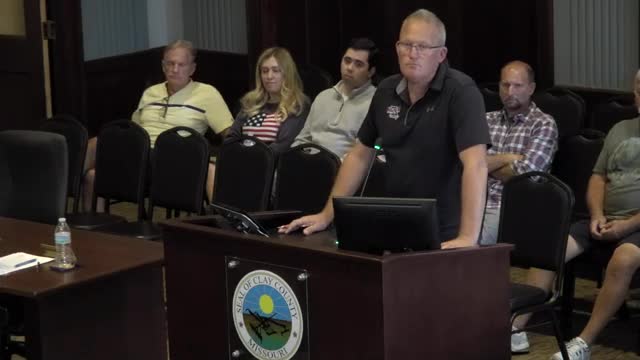Residents clash over farmland development and safety concerns
September 04, 2024 | Clay County, Missouri
This article was created by AI summarizing key points discussed. AI makes mistakes, so for full details and context, please refer to the video of the full meeting. Please report any errors so we can fix them. Report an error »

In a recent government meeting, board members and community members engaged in a heated discussion regarding land use and agricultural practices in Clay County. The conversation was sparked by concerns over the fragmentation of large farms into smaller residential lots, which some members argue is detrimental to both agriculture and community safety.
One board member expressed frustration over the current zoning regulations that require road frontage, leading to the division of farms into narrow strips. This practice, they argued, not only wastes valuable agricultural land but also creates challenges for farmers who are struggling with overproduction. The member emphasized the importance of maintaining larger tracts of land for farming, suggesting that a minimum of three acres would be more manageable for residents and beneficial for agricultural use.
Another speaker, a local farmer with deep roots in the area, echoed these sentiments, highlighting the challenges faced by farmers in the current economic climate. They noted that converting farmland to residential use could lead to conflicts between agricultural activities and new homeowners, particularly regarding safety and noise from farming operations.
Jim Graham, a resident with property adjacent to a proposed development, raised concerns about the impact of new housing on existing agricultural practices. He pointed out that the influx of wealthier residents could lead to tensions, especially if they are unaccustomed to living near active farmland. Graham also highlighted safety issues on local roads, citing multiple incidents where vehicles have veered off the road, raising alarms about the adequacy of infrastructure to support increased traffic from new developments.
The meeting underscored the ongoing debate in Clay County over balancing agricultural preservation with residential development, as community members grapple with the implications of zoning laws and land use policies. As discussions continue, the board faces the challenge of addressing the needs of both farmers and new residents while ensuring the safety and sustainability of the community.
One board member expressed frustration over the current zoning regulations that require road frontage, leading to the division of farms into narrow strips. This practice, they argued, not only wastes valuable agricultural land but also creates challenges for farmers who are struggling with overproduction. The member emphasized the importance of maintaining larger tracts of land for farming, suggesting that a minimum of three acres would be more manageable for residents and beneficial for agricultural use.
Another speaker, a local farmer with deep roots in the area, echoed these sentiments, highlighting the challenges faced by farmers in the current economic climate. They noted that converting farmland to residential use could lead to conflicts between agricultural activities and new homeowners, particularly regarding safety and noise from farming operations.
Jim Graham, a resident with property adjacent to a proposed development, raised concerns about the impact of new housing on existing agricultural practices. He pointed out that the influx of wealthier residents could lead to tensions, especially if they are unaccustomed to living near active farmland. Graham also highlighted safety issues on local roads, citing multiple incidents where vehicles have veered off the road, raising alarms about the adequacy of infrastructure to support increased traffic from new developments.
The meeting underscored the ongoing debate in Clay County over balancing agricultural preservation with residential development, as community members grapple with the implications of zoning laws and land use policies. As discussions continue, the board faces the challenge of addressing the needs of both farmers and new residents while ensuring the safety and sustainability of the community.
View full meeting
This article is based on a recent meeting—watch the full video and explore the complete transcript for deeper insights into the discussion.
View full meeting
